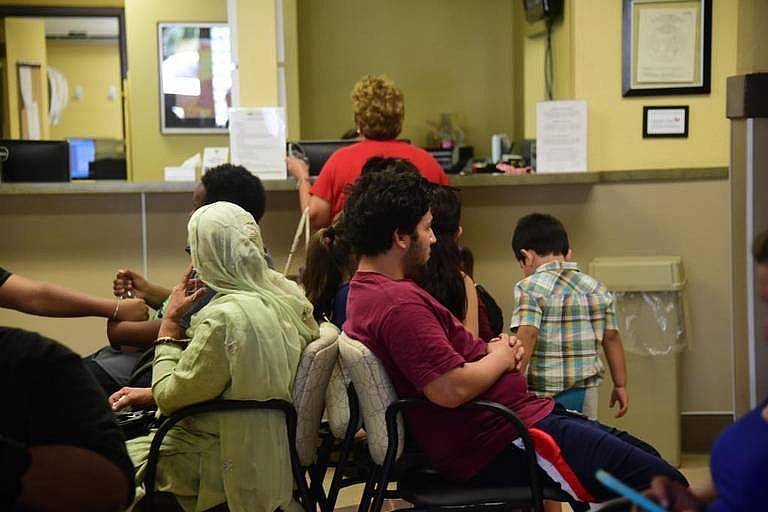Merced’s doctor shortage is getting worse. But it’s not a new problem.
This story is the second in a three-part series. Monica Velez’s reporting on healthcare barriers for low-income residents in Merced County was undertaken as a fellow of the California Health Journalism Fellowship at USC’s Annenberg School of Journalism.

Patients awaiting their doctors appointments in the waiting room of a Livingston Community Health clinic in Livingston on Aug. 31, 2017. The number of patients visiting Livingston Community Health clinics in Merced and Stanislaus has doubled since the closures of Horisons Unlimited Health Care clinics, making it that much harder for a patient to see a doctor when they need one, said Leslie McGowan, CEO with Livingston Community Health. Monica Velez
Cierra Shelton, a 30-year-old mother of two, has been struggling to find a consistent primary care doctor in Merced County for as long as she’s been an adult.
But her more than decade-long hunt to find doctors who consistently accept her Medi-Cal insurance has been difficult. Her limited options keep her waiting for weeks, sometimes months, to see a doctor. That problem got worse last month when her clinic, Horisons Unlimited Healthcare, filed for bankruptcy and closed amid lawsuits alleging financial abuse, exorbitant executive salaries, nepotism and cronyism.
Shelton is willing to travel outside of the county to receive care. But she can’t. She’s limited to Merced County because of her Medi-Cal insurance, the same insurance covering more than half — 51 percent — of Merced County residents, about 127,000 people, according to a recent study from the Merced County.
“It seems to be designed to make everything harder,” Shelton said.“It’s frustrating to the point that I cry about it. You have to be your own advocate. You have to argue your case to everyone to get the health care you need.”
But these problems are not new in Merced County.
In fact, before Horisons closed, a 2016 report from the Merced County Department of Public Health painted a bleak picture of years of doctor shortages in the region primarily affecting low-income residents.
Merced County has had one of the worst shortages of medical professionals in California, ranking nearly last in the state with only 45.4 physicians per 100,000 residents. The statewide rate is about 77 doctors per 100,000 residents, according to the 2016 Community Health Assessment.
Emergency Room Visits on the Rise

Years of doctor shortages have made poor residents in Merced County more vulnerable to preventable illnesses.
Heart disease, which can be managed and avoided, is the leading cause of death in the county, the study found, and claim more lives in Merced County, on average, than in most of the rest of the state. The report also found that hypertension-related deaths are increasing in the county.
Managing conditions like asthma, diabetes and hypertension should be handled by a primary care doctor, but that’s not happening for too many people in Merced County, according to Leslie McGowan, chief executive officer for Livingston Community Health.
“In some cases, if patients feel like they’re experiencing illness and can’t get in and can’t get treatment, the next place they end up is in urgent care or the emergency department,” McGowan added.
The health assessment found that nearly half of all adults in Merced County – 43.8 percent – reported difficulty and delays obtaining care in the last year. In 2015, 11.7 percent of all emergency room visits in the county were the result of lack of access to preventative care.
Emergency rooms visits at Mercy Medical Center in Merced have been steadily climbing in recent years, according to Phil Brown, director of emergency services at the hospital. A great number of those visits should have been handled by a primary care doctor, Brown acknowledged.
“This is not new,” Brown said. “We’ve been dealing with community challenges and adjusted things.”
The Health Department study argued for the county to put local resources into bringing more doctors to the area, but history has shown that’s much easier said than done in Merced County.
[This story was originally published by Merced Sun-Star.]

